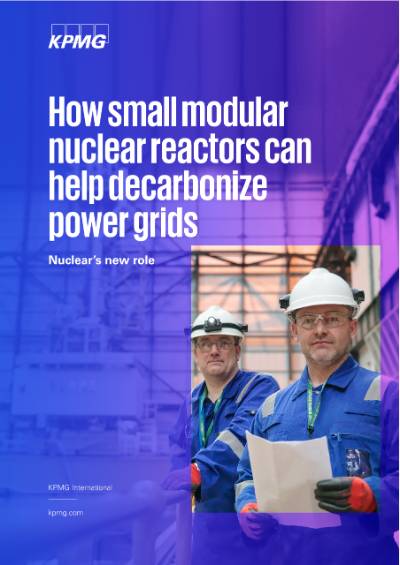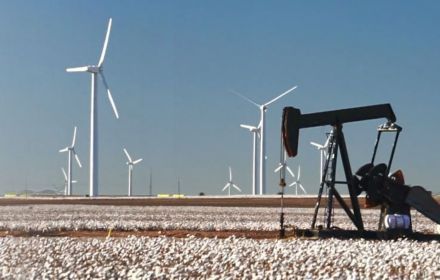Most countries now recognize the need to decarbonize their economies to slow climate change, with more than 90 percent of global emissions covered by Net Zero commitments after November 2021’s COP26 conference in the UK1. The event focused on the need to retire coal-powered plants by 2030 in advanced economies and worldwide a decade later, agreeing funds to accelerate the development of renewable energy.
Renewable sources are increasingly filling some of the gap left by coal and other fossil fuels. But while they have an important role to play, they have their own issues. Wind is intermittent in output and has local environmental impacts, including the requirement to site the current generation of large wind turbines across vast land and sea areas. Solar is predictable in output but requires significant amounts of land beyond roof-mounted panels, making it less suited to highly-populated areas. Hydroelectric, the most developed renewable energy source, can provide consistent and controllable output but often involves flooding land. National potential to exploit specific renewable sources varies enormously – offshore wind is more consistent than onshore, does not require land and is falling in cost, but this does not help countries with little or no coastline.
All this means that countries should also look to include nuclear in their plans to replace fossil fuel electricity generation. Nuclear power does not generate greenhouse gas emissions in its production but through mining and refining uranium, transporting and storing waste and constructing and decommissioning sites. However, these add up to a fraction of those produced by coal and natural gas. Figures vary widely, but one attempt by the World Information Service on Energy to calculate a lifecycle cost estimated that it generates between 88 and 146 grams of carbon dioxide equivalent per kilowatt-hour2. Our World In Data, a research resource run in association with the University of Oxford, has a much lower figure of 3g, just below wind (4g) and solar (5g). Both the nuclear emission estimates are far lower than those for fossil fuels, with natural gas generating 490g, oil 720g and coal 820g.3 The International Energy Agency believes nuclear power has significant potential to contribute to the world’s shift to clean energy, with its use having avoided nearly two years’ worth of global energy-related carbon dioxide emissions.4
Nuclear has an excellent safety record, despite fears over its use. A calculation of deaths caused by accidents and air pollution by Our World In Data found that nuclear power was responsible for 0.03 deaths for each terawatt hour (TWh) generated, similar to wind and solar power. This was a tiny proportion of those caused by natural gas (2.8 deaths per TWh), oil (18.4 deaths per TWh) or coal (24.6 deaths per TWh). It notes that accidents have strongly influenced people’s perceptions of nuclear’s safety, but that major nuclear accidents have resulted in far fewer deaths proportionately than any other forms of electricity generation, including those at power plants and those resulting from material leakages.5
As well as lowering carbon emissions and increasing safety, there are good arguments for directly replacing coal or natural gas heat generation in power plants with nuclear units. This would allow the reuse of equipment and infrastructure and, in some countries, could see a repowered station continue under its existing operating license. Nuclear, like oil and gas, is well-suited to generating a ‘baseline’ of electricity at a steady and reliable level that is needed to complement variable outputs from wind and solar. (The reliability and flexibility of fossil fuels are reasons they have remained popular despite their environmental impacts.) Nuclear can also improve energy security as power is generated within a country’s borders with less reliance on deliveries by ship or pipeline than fossil fuels.
Why small modular reactors?
Compared to renewable generation, a clear disadvantage of nuclear reactors has been the cost and effort required for building and commissioning. As one-off projects, nuclear power stations generally cost tens of billions of dollars or pounds and are notorious for exceeding budgets and deadlines. French state-owned utility EDF is currently constructing Hinkley Point C on the coast of Somerset in the UK, with an original project cost of GBP18 billion.6 In May, EDF said the project will cost the company between GBP25-26 billion in 2015 values to complete and will open 18 months later than originally planned in June 2027.7 Such stations need extensive amounts of land and typically require constructors to obtain numerous permissions before work starts.
By contrast, small modular reactors (SMRs) should cost hundreds of millions of dollars each. An SMR will take up much less space than a conventional nuclear station and should be even safer, given its smaller size. Multiple projects can be deployed as a program of work, allowing equivalent project risks and costs to be spread.
This size also means SMRs provide a greater opportunity to repower existing coal and natural gas stations as nuclear ones. The three sources generate electricity in the same way – they create heat that turns water into steam, which spins turbines to generate electricity – meaning some elements of coal and gas stations could be reused. The sites also have grid connections, access to water for cooling where required, land and experienced staff. Turning them into SMR nuclear stations would also lessen the job losses, falls in tax income and local spending that an area would experience if sites close.
US climate change not-for-profit TerraPraxis has proposed repowering 5,000 to 7,000 coal plants globally with SMRs between 2030 and 2050. Its Repowering Coal Initiative, developed with a consortium including design and engineering consultancy Bryden Wood, software provider Microsoft, academic partners and KPMG professionals, is developing standardized, pre-licensed designs and automated project and design tools to support utilities wanting to switch from coal to SMR nuclear.8 In the US alone, a report for the Department of Energy recently estimated that 315 sites, making up around 80 percent of retired and currently operating coal plants the report evaluated, could be converted to nuclear power.9
A demonstration repowering project has been agreed upon for Kemmerer, Wyoming, in the US, by TerraPower, an innovation company founded by Bill Gates. The company plans to build an SMR unit next to utility PacifiCorp’s Naughton coal power plant, which is scheduled to close in 2025.10 The US Department of Energy plans to invest nearly USD2 billion in the project, noting that about 80 percent of Wyoming’s electricity comes from coal-fired stations and that in 2019 PacifiCorp, which is the state’s largest utility, said it plans to close two-thirds of its coal fleet by 2030.11
As well as repowering coal plants, SMRs could provide heat or electricity for energy-intensive industrial processes such as steelmaking and hydrogen fuel production. Cleanly-produced hydrogen (often known as green hydrogen) is set to contribute to Net Zero efforts by providing a dense and mobile store of energy that could replace fossil fuels for long-distance freight, shipping and aviation.12
Whether replacing coal in power plants or supplying industrial processes, SMR reactors have the potential to be installed in a packaged fashion based on standardized designs and processes. This should mean they can be deployed more quickly and with greater certainty over the likes of outcomes, costs and regulatory approvals than nuclear power has to date.

What are SMRs?
The International Atomic Energy Agency defines a small modular reactor as having an electricity output of up to 300 megawatts electric, about a third of the output of a conventional reactor, and takes up a fraction of its physical size. An SMR is built in a modular fashion in a factory and shipped as a unit to where it will produce power, rather than assembled on-site13. There are only a few models of SMR reactors operating worldwide at present, although there are several dozen more under construction, planned for deployment soon or at earlier stages according to the World Nuclear Association.14
The need to standardize and decouple
Standardization is expected to be key to the successful introduction of SMRs. This means that manufacturers should collaborate to help minimize differences required by national regulations. The automotive industry often uses common ‘platforms’ (broadly, the floor of a vehicle and the components located there) across many models in different countries. This allows for relatively small local adaptations, such as placing the driver on the left or the right without extensive redesign work. A similar approach with SMRs could help minimize development costs while complying with local requirements, as well as deepen talent pools and assist international adoption by allowing those trained on SMRs in one country to work elsewhere. International standardization would also help enable a ‘turnkey’ construction model where builders and infrastructure operators collaborate to deliver SMRs to operators ready for use.
As well as supporting international standardization by harmonizing regulations where possible, governments should reconsider the way they regulate nuclear installations. At present, such regulations typically cover entire sites making compliance expensive. While this approach may be appropriate for custom-built plants, the shift to SMRs provides the opportunity to decouple the regulation of the ‘nuclear island,’ the unit that generates heat, from the accompanying equipment used to generate electricity. For SMRs, the latter could be treated as non-nuclear, cutting the costs and burdens of meeting regulations.
Recommendations for governments
SMRs provide countries with the opportunity to generate electricity that is low-carbon, safe and reliable in output. They can repower coal and natural gas plants as nuclear ones, reusing existing equipment and infrastructure and maintaining local jobs and economic output. But governments will need to support this for it to happen.
Governments should develop streamlined licensing processes for SMRs to encourage investment and decouple ‘nuclear islands’ by applying nuclear regulations only to SMR units rather than entire power plants. Governments will also need to reform and simplify regulations in ways appropriate to a shift from large custom-designed nuclear plants to smaller standardized units. It may make sense to harmonize national regulations with international best practices, so manufacturers can aim to minimize changes rather than develop different versions for each country.
Governments can help the financial viability of SMRs by encouraging heat-intensive manufacturing and other complementary businesses, such as users of isotopes in sanitizing medical products, to locate near such units in nuclear business parks. They can also reform planning regulations to provide policy direction and, where appropriate, financial incentives for installing SMRs.
Finally, governments that want to use SMRs should make the case for doing so through open public debate based on facts and data. Nuclear power suffers from the same problem as aviation in that accidents are very rare but can be catastrophic, making them global news when they do happen. With the advent of standardized, smaller SMR technology, there is a strong safety case for governments to make, particularly when this is combined with opportunities to cut carbon emissions and increase energy security.
Contact us
Connect with us
- Find office locations kpmg.findOfficeLocations
- kpmg.emailUs
- Social media @ KPMG kpmg.socialMedia
Related content
1 UN Climate Change Conference UK 2021, ‘COP26: the Glasgow climate pact’, November 2021. https://ukcop26.org/wp-content/uploads/2021/11/COP26-Presidency-Outcomes-The-Climate-Pact.pdf
2 Jan Willem Storm van Leeuwen, World Information Service on Energy, ‘Climate change and nuclear power: an analysis of nuclear greenhouse gas emissions’, 2017. https://wiseinternational.org/sites/default/files/u93/climatenuclear.pdf
3 Hannah Ritchie, ‘What are the safest and cleanest sources of energy?’, Our World In Data, 10 February 2020. The figures are expressed in tonnes per terawatt hour, which is numerically equivalent to grams per kilowatt hour. https://ourworldindata.org/safest-sources-of-energy
4 ‘Nuclear’, International Energy Agency. https://www.iea.org/fuels-and-technologies/nuclear
5 Hannah Ritchie, ‘What was the death toll from Chernobyl and Fukushima?’, Our World In Data, 24 July 2017, https://ourworldindata.org/what-was-the-death-toll-from-chernobyl-and-fukushima
6 ‘Hinkley Point C project cost’, EDF, 12 May 2016. https://www.edfenergy.com/energy/nuclear-new-build-projects/hinkley-point-c/news-views/cost-clarification
7 ‘Hinkley Point C update’, EDF, 19 May 2022. https://www.edf.fr/sites/groupe/files/epresspack/3081/ccb6205433272bb0cbfac560cea3b537.pdf
8 ‘Repowering the global coal fleet by 2050’, TerraPraxis, March 2022. https://www.terrapraxis.org/projects/repowering-coal
9 ‘Investigating benefits and challenges of converting retiring nuclear coal plants into nuclear plants’, prepared for US Department of Energy, 13 September 2022. https://fuelcycleoptions.inl.gov/SiteAssets/SitePages/Home/C2N2022Report.pdf
10 ‘TerraPower selects Kemmerer, Wyoming as the preferred site for advanced reactor demonstration plant’, TerraPower, 16 November 2021. https://www.terrapower.com/natrium-demo-kemmerer-wyoming/
11 ‘Next-gen nuclear plant and jobs are coming to Wyoming’, US Office of Nuclear Energy, 16 November 2021. https://www.energy.gov/ne/articles/next-gen-nuclear-plant-and-jobs-are-coming-wyoming
12 Abhinav Chugh and Emanuele Taibi, ‘What is green hydrogen and why do we need it? An expert explains’, World Economic Forum, 21 December 2021. https://www.weforum.org/agenda/2021/12/what-is-green-hydrogen-expert-explains-benefits/
13 Joanne Liou, ‘What are Small Modular Reactors (SMRs)?’, International Atomic Energy Agency, 4 November 2021. https://www.iaea.org/newscenter/news/what-are-small-modular-reactors-smrs
14 ‘Small nuclear power reactors’, World Nuclear Association, updated May 2022. https://www.world-nuclear.org/information-library/nuclear-fuel-cycle/nuclear-power-reactors/small-nuclear-power-reactors.aspx







